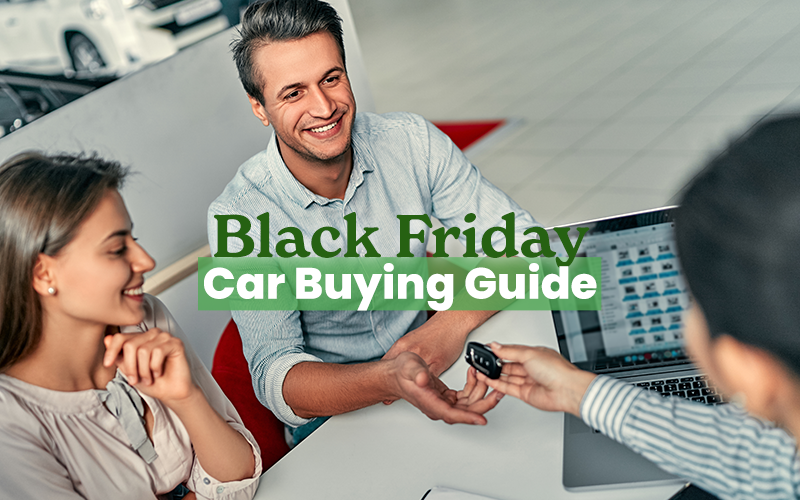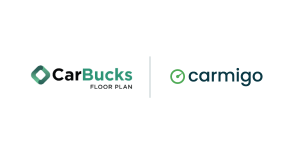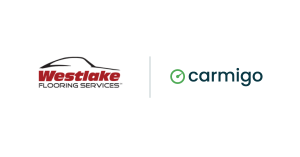- How to Buy a Car
Carmigo’s Insider Guide to Getting the Best Deal on a Car this Black Friday.
Table of Contents
Save Even More When You Buy (Or Sell) on Black Friday
If you need a new car, Black Friday is as good a weekend as any to buy one — other than the crowds. And this car buying guide will help you plan ahead to get the best deal.
Most car dealerships run sales that often stack on top of the monthly promotions and holiday promotions offered by manufacturers. You may even be able to skip the down payment or lock in a lower interest rate.
But if you don’t prepare before shopping, you may spend more even after all the discounts.
What Is This Car Buying Guide?
We’ll walk you through the steps of buying a car the way we would do it. And since most of us have worked in and around car dealerships for most of our careers, we have some inside knowledge.
To assemble this car buying guide, we talked to the experts at Carmigo, summarized the current market conditions, and even sat down for a Q&A with our Inside Sales Representative.
This Black Friday weekend, we’ll waive our $350 sell fee. That’s right, we’ll help you sell your car for free.
Fall 2022 Market Report
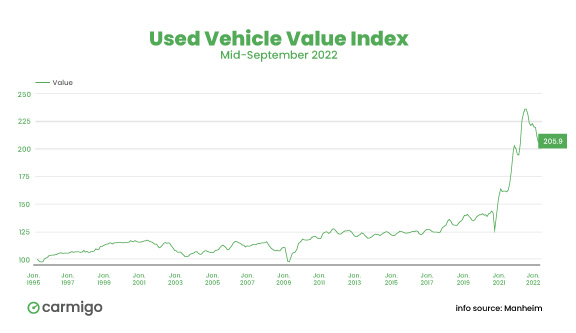
This summer, car dealerships and private sellers sold cars for all-time record prices. It was almost impossible to buy an affordable car. But at the same time, it was easier than ever to sell a car and walk away with plenty of money.
Every peak has a fall, and this fall, we’re seeing vehicle prices going down this fall. Private vehicle owners are more reluctant to part with the vehicles at lower prices, but dealerships are no longer having to charge more for waitlisted vehicles.
So if you’re buying a car soon, this fall is as good a time as any, and since the used car market is so much slower than it was this summer, you may get an even better deal than usual if you buy used. Follow the steps in this car buying guide to make sure you get the most out of your purchase
Sell Now if You’re Selling
If you plan to buy a car in winter, it might be worth your while to try to sell your old one sooner.
If current trends hold, used cars will continue to sell for lower prices for the remainder of the year before leveling out.
Similarly, new cars are in higher supply and selling much closer to MSRP than this summer. So selling now could be the difference of a thousand bucks (but that’s just our best guess).
Sell For Free Black Friday Weekend
Complete your vehicle profile on the Carmigo marketplace from November 24 until November 27, and we’ll waive Carmigo’s $350 sell fee when it sells.
There is no commitment to sell or even list your car, but we’re only turning off the sell-fee Black Friday weekend, so go ahead and complete your profile just in case. All you have to do is take a few pictures, answer a few questions, and set a minimum price.
Then, if you decide to sell it on the marketplace, we’ll waive the sell fee.
Get started at Carmigo.io.
Buying A Car? Don’t Do It Until You’ve Done These Eight Things.
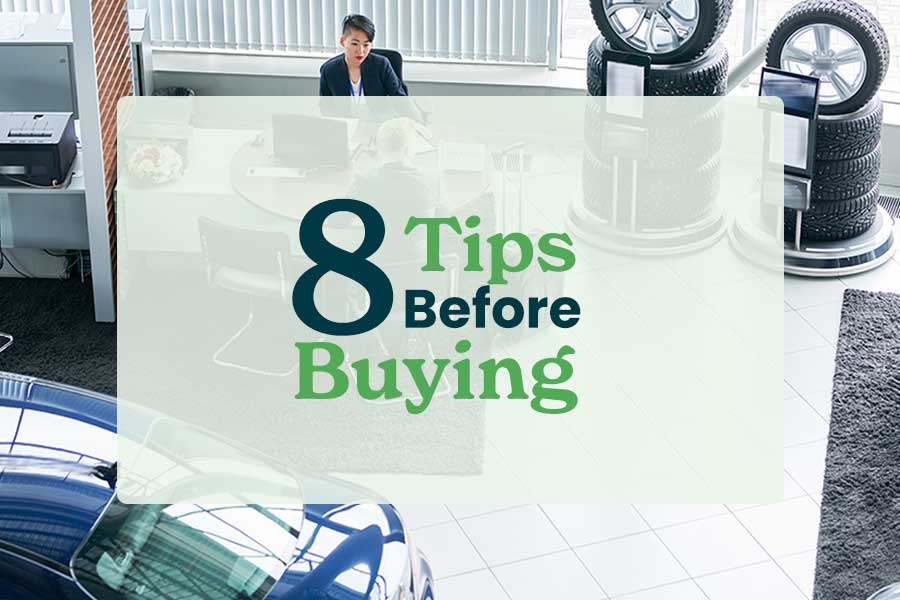
When you buy a car, you’ve got to make what feels like 100 decisions before you even get to the dealership. And then you’re so worried you’re not getting a good deal that you start making knee-jerk decisions.
Buying a car is overwhelming. But with a bit of pre-purchase prep, the process can be much easier (and cheaper).
1. Get Pre-Approved and Set a Budget Before Buying a Car
Starting with a budget is such an obvious step in buying a car that it often gets overlooked. Knowing what you can afford will determine the type of car you buy and the dealership or private seller you buy it from.
You can sit down with your bank statements and figure out what you can afford or apply for a pre-approved loan from your bank. Banks typically don’t want to lend out more than their customers can afford, so they’ll give you a ballpark estimate.
Once you have a price range, you can better understand what makes and models you can afford and which dealerships will be the best fit.
2. Start With Your Need / Not Your Want
Carmigo’s Inside Sales Representative, Dylan, says starting with your need will save a lot of hassle later on and probably save you money.
“Ask yourself what you’re really going to use this car for. Are you traveling a bunch for work? Do you need a truck to pull a horse trailer? Are you driving a bunch of kids around?”
Don’t buy a brand new small car if you’re planning on having more children. Go for a minivan.
Don’t buy an SUV or a truck if you’re commuting and already on a tight budget.
Cars are typically long-term purchases. Plan your purchase with the next five years in mind.
3. Research the Cars
Now that you know your budget and body type, it’s time to narrow down the models, decide whether to buy new or used ones, and pencil in some expected prices.
Most models are similar when sorted by body type. The Honda Civic and Hyundai Elantra achieve a similar purpose.
The same goes for makes. Toyotas have similar add-ons, pricing structures, and technology across models. Hondas are similar to Hondas, Fords are similar to Fords.
So as you think more about what you need in a car, find the make, model, and body type combinations you like best. You may like how it feels to drive a CR-V but prefer a Toyota crossover’s technology and luxury upgrades.
Since the CR-V and Rav4 are relatively equal in this example, price, availability, and dealership could become factors when buying a car.
4. Know the MSRP and the Market
Every new car has a sticker price (manufacturer-suggested retail price or MSRP), and every used car has a Kelley Blue Book Value, but that’s not always the whole story.
A new Camry may retail at $25,845, but if there are supply issues, you can expect to pay more. However, if sales are slow, you may be able to get a new Camry for $23,000.
Find out how much money cars are being listed for compared to how much they’re actually selling for.
5. Research the Dealerships
All dealerships seem pretty similar on the surface, so it’s hard to know which to choose when buying a car. They’ll sell you a vehicle. They probably all have some used cars. They’re all trying to make some margin on the sale to pay the bills, and most of them have lots of experience processing all the paperwork and service issues.
But it’s still a five-figure decision, so you want to ensure you buy a car from someone you trust.
Here’s what Dylan says: “Find someone that you know isn’t going to pressure you to make a knee-jerk decision to buy a vehicle you don’t want or can’t afford.”
Search dealerships in your area that carry the models you’re interested in and have good reputations. Consider which ones have highly-rated service departments, especially if you’re buying a new car.
6. Research Trims and Add-Ons Ahead of Time
Most sellers will try to get every dollar they can for extra investments they’ve made in the car. And they should. But don’t take their word for how much you should pay.
Before you go to the dealership, you should know that each model has a variety of add-ons and features that can create $20,000+ differences in how much a car costs.
For instance, an entry-level F150 is about $33,000, while the fully-maxed-out F150 Limited costs $5,000. Figure out where your needs fall within that range.
And then there are added warranties, floor mats, and better wheels or tires. Most of those things can be purchased later. Make sure you know how much those things cost before buying a car. You’ll probably be overwhelmed with decisions and paperwork that day. You don’t want a stressful decision to be the difference of a few hundred extra dollars on your monthly payment.
7. Read the Vehicle History Before Buying a Car
If you’re buying a car that’s been used before, it’s key to check the vehicle’s history report. Carfax is the most common vehicle history report brand.
It will show you if the previous owners have maintained the vehicle over the years and note any wrecks or damage.
8. Sell Your Old Car
The hardest part about buying a new car is selling your old one. You basically have three options, each with its pros and cons:
Private Sales can sometimes bring in a little bit more money but require the seller to do all the paperwork, handle negotiations with strangers, and advertise the sale. This often comes with fielding lots of calls from people who already know they will not buy your car.
Dealerships Trade Ins are one of the easiest ways to sell your car. But (and this is a big but), dealership trade-ins often fetch the lowest price.
Online car sales have taken off in recent years. Carmax and Carvana are two notable online buyers. The issue with each is that it’s one company making one off on your car based on that one company’s needs.
Carmigo is a more decentralized online option for selling your car. With the Carmigo marketplace, you can list your car to a network of more than 100 buyers around the country. Carmigo listings typically get multiple offers in as little as one day.
This Black Friday weekend, we’ll waive our $350 sell fee. That’s right, we’ll help you sell your car for free.
How To Buy A Car: From An Industry Insider
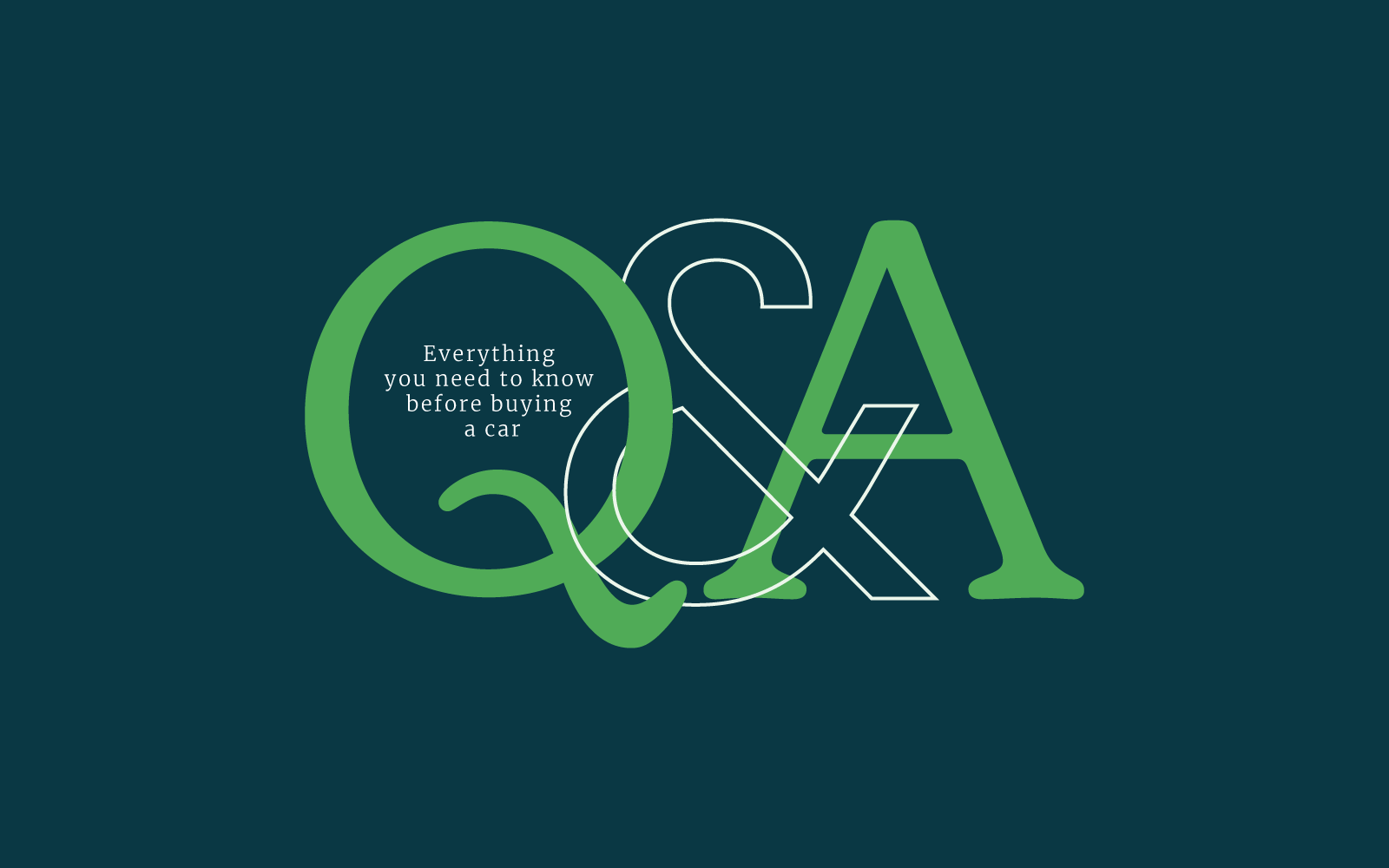
Carmigo’s Inside Sales Representative, Dylan, knows how to buy a car because he’s seen car sales from all sides. We asked him for the scoop, and here’s how he would shop:
Read the entire How to Sell Your Car Q&A here.
What questions should I be asked before I start shopping?
It’s easy to think about the cars we want, but to get the most value out of your purchase, start with the need:
- Are you traveling for work?
- Do you need a truck to pull horse trailers?
- Are you driving kids to practice?
How important is the dealership?
You want to find a dealer that’s got a good reputation. When you’re spending this much money, it’s important to find someone you trust. You don’t want to go to a dealership you’re unsure about. And while most dealerships are great, it’s working with someone you trust will be less stressful. The less stress you have, the more clearly you can think.
Does the individual salesperson make a difference in how to buy a car?
The salesperson is the go-between for you and the sales managers. Obviously, the sales managers are the ones that are setting prices. But your salesperson is going to be an important part of the process. So you want someone you know isn’t going to pressure you to make a knee-jerk decision to buy a vehicle you don’t want or can’t afford.
What if I show up to a lot and the dealership doesn’t feel like the right fit?
Most salespeople know everybody at the other local dealerships. So there’s something that they may not have you can get at another lot. They may say, “Hey, go see so-and-so across the street. They’ll take care of you.” Obviously, they want to make the sale. But if they can’t make the sale, they can refer you to someone that they know who will take care of you and help you find what you want.
Why does MSRP matter?
MSRP is the manufacturer suggested retail price. Because of the car market, most dealers are adding an addendum to that. So they’re not going off the MSRP and adding an additional cost.
When it was hard to get inventory this summer, it cost more to transport parts and vehicles, so they were marking the price up to adjust to market prices at that time.
But take, for instance, trucks: The dealers might put some different wheels, tires, and lift kits on there. So having an addendum for that may be something other than a market adjustment. It may just be for those accessories they put on the vehicle.
In a tight market, you might pay over MRSP. In a market with availability, you may pay under. Dealerships don’t have to make as much money on each sale if they’re selling 40 versus 10.
How much does the dealership make?
Most reputable dealers are not there to make a ton of money off of you. They’re going to want to make a little bit of money, but the average is going to be around $1,500 to $2,000. They’re not there to make 10-15 thousand dollars like many people think. But they still have to pay for the vehicle.
Should I buy a used car directly from the owner?
A private party sale has some benefits. The main benefit is that you could get the vehicle a little cheaper just because a private party will not have the overhead a dealership has.
But you take a lot of risk with a private party. They may not be truthful about the vehicle’s condition, mechanically or cosmetically. You may not be able to ask for a carfax history report — to see if they take the vehicle has been in a wreck.
If you ask for a dealership, a dealership can provide that for you.
And a dealership, once they get the car in, runs it through the service department, and they fix the issues that are wrong with the vehicle before they put it out on the lot to resell it.
Plus, there’s the aspect of titles. If you don’t buy and sell cars daily, you may not know how to handle titles and loan paperwork. When you go to a dealership, they’re taking care of all the paperwork for you versus a private party where you will have to call around and jump through hoops to get that title corrected.
And then you’re taking the risk of simply meeting a stranger, which can be stressful or even unsafe.
When you buy a car, what steps do you take?
- The first thing I do is figure out my need for the vehicle. Right now, my need for a car is to have something that gets good gas mileage since I’m traveling for work. So, My initial reaction would be to look at fuel-efficient vehicles.
- I’ll do a little research on that to find out what specific makes or models I may want to look at.
- Then, I would research the dealership. If I know I want a Honda Accord, I will look for a Honda dealer. I’m going to read reviews. I’m going to look at their inventory.
- Next, I’ll go by their lots just to see how they keep their vehicles looking.
- Finally, once I figure out the vehicle and the dealership I want to use, I will go to the dealership to try to work a deal out with them.
If You’re Buying, You’re Probably Selling
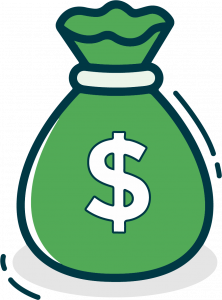 The hardest part about buying a new car is selling your old one.
The hardest part about buying a new car is selling your old one.
Do you sell it yourself? Can you get a good trade-in offer at a dealership? Is it safe to sell it online?
Each option has its pros and cons:
Private Sales can sometimes bring in a little bit more money but require the seller to do all the paperwork, handle negotiations with strangers, and advertise the sale. This often comes with fielding lots of calls from people who already know they will not buy your car.
Dealerships Trade Ins are one of the easiest ways to sell your car. But (and this is a big but), dealership trade-ins often fetch the lowest price.
Online car sales have taken off in recent years. Carmax and Carvana are two notable online buyers. The issue with each is that it’s one company making one off on your car based on that one company’s needs.
Carmigo is a more decentralized online option for selling your car. With the Carmigo marketplace, you can list your car to a network of more than 100 buyers around the country. Carmigo listings typically get multiple offers in as little as one day.
The Easiest Way to Sell Your Car
If you’re thinking of selling privately or accepting a dealership’s trade-in offer, consider listing your car on the Carmigo marketplace first. There’s no obligation to sell unless the highest bid meets or beats your minimum price.
You can complete a virtual inspection of your car in 15 minutes using the camera on your phone, and we’ll create a vehicle listing and distribute it with the inspection to our network.
You can do it from anywhere, and we’ll handle the paperwork when it sells. Plus, we’ll pick it up.

